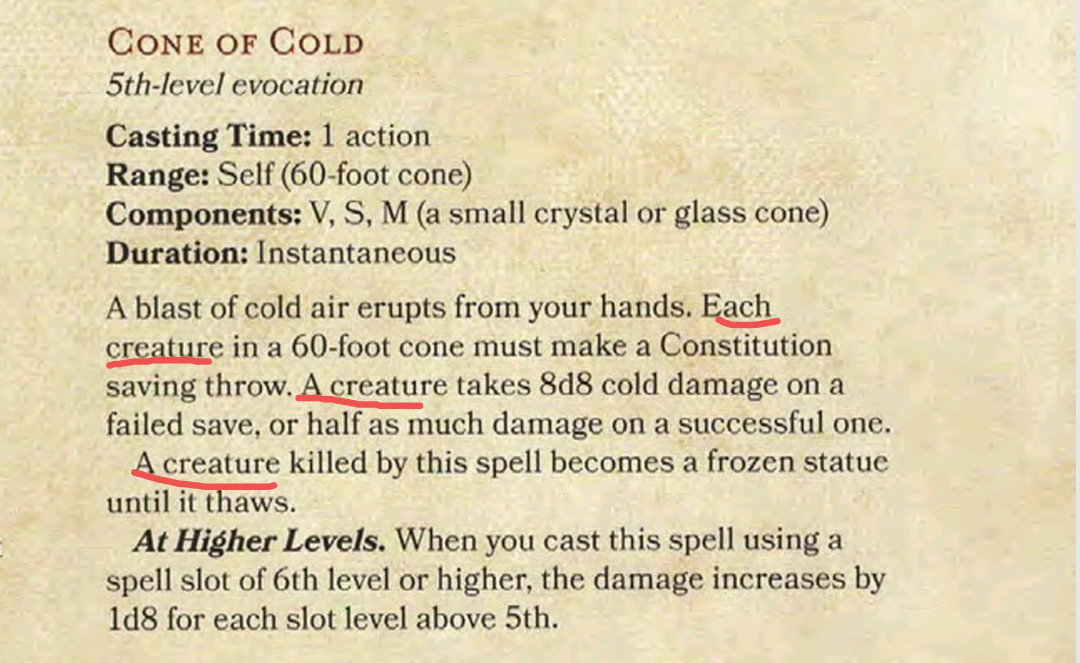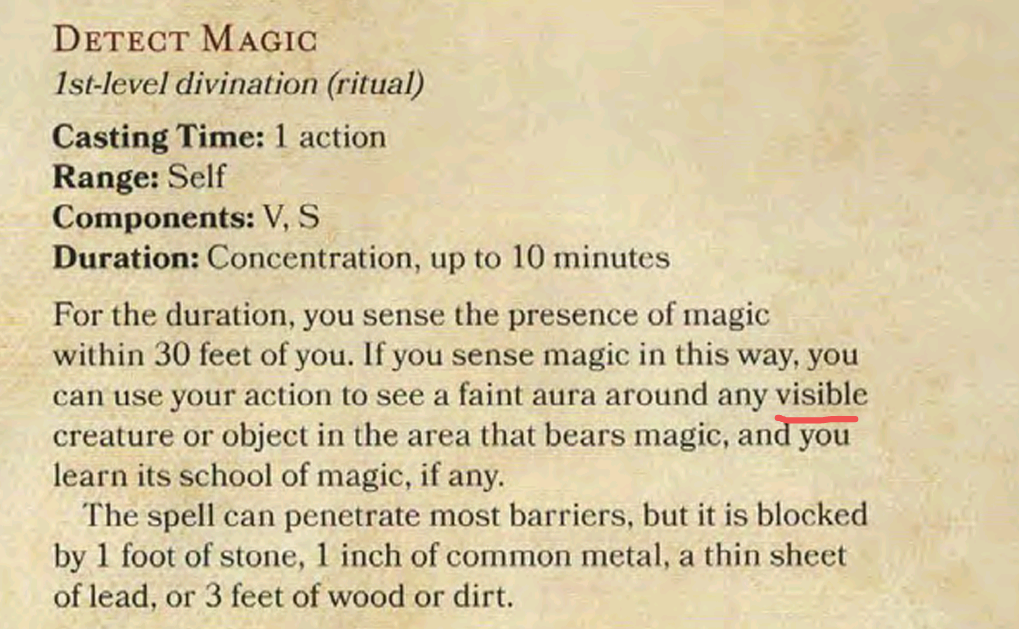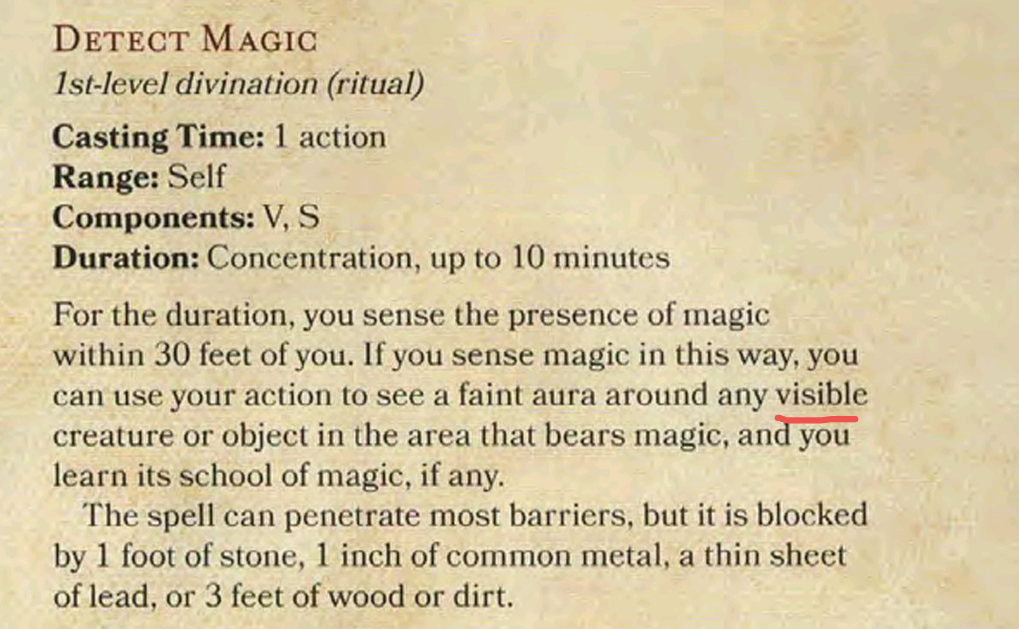There are two fun things you can do with D&D. You can be pointlessly pedantic with the rules, and you can play. As long as you don’t do both at once you’re good.
Not going to lie. People who argue for rules like Jesse in the meme, makes me not want to play D&D.
You are not bound to engage with the topic. For most here I assume it’s just goofing around.
D&D’s invisibility rules are goofy. At least in the (2014 edition, groan) you always get advantage of you’re invisible and attacking someone. Even if they can see you. The invisibility condition is worded like "you get advantage on attacks"instead of “Since you’re hidden, remember you get advantage on attacks”.
Exactly. Same line of stupidity imo.
In my campaigns, Mystra does not take kindly to pedants or loophole researchers. A spell does what Mystra allows it to do, and you cast what Mystra allows you to cast
Mfs gotta remember that magic is a person, and that person can get annoyed
That’s a weird way of saying that she does not like Wizards. Because if you study something enough, you are bound to find loopholes.
And then you’ll figure out how to cast a 12th level spell to steal the power of a god. Mystra learned her lesson the hard way.
But if you want to play RAW, go ahead. Oh, you died and you want to be brought back to life? Sorry, the spell targets a “creature that died in the last minute”, and now that you’re dead, you’re an object.
Magic may be a fickle bitch, but she likes pedants more than wild mages. 🤷🏼♂️
I would go line of fire logic.
You theoretically can not target the wall, but you can target something on the outerside and will then hit the wall instead
If there’s a line of effect between you and the target, no matter how circuitous it is, the target is hit. If there isn’t one, it has total concealment and can’t be targeted. If you’re going to ignore RAW and play like a reasonable person, just let people target the wall.
As I have said in another comment, that is RAW not what would happen:
“You can’t even cast it on something behind the wall, because you cannot target something (or someone) with a spell if they are behind total cover. Total cover is created by being behind completely behind an obstacle (like a wall). This counts even if the obstacle is invisible.”
Furthermore, because if you chose an invalid target for a spell, you’d still expend the spellslot but there would be no effect. So you actually spend a sixth level spell a lot to achieve nothing."
It’s very much not RAI I’d say and I would likely handle exactly like you described, but the RAW was so wonky that I wanted to make the meme when I found out about it.
“Specific overrides general” is RAW though, and the spell description of Wall of Force calls out that exact spell interaction as a way to destroy it.
It just says you can cast it on a creation of magical force, such as the wall created by Wall of Force. It does not say that you can do it without first casting See Invisibility.
Though would that work? The wording in Disintegrate lists a creature or object separately, implying a Wall of Force is neither. Since See Invisibility only lets you see creatures and objects, it wouldn’t let you see a Wall of Force.
The wording simply says “a disintegrate spell”. It does not say what it has to be cast on or wether it continues to travel towards the real target afterwards. But the implication clearly is that you have to hit the wall. Thus, RAW, even with specific overriding general, you cannot target the wall because it is invisible (nothing in its spell description states otherwise) and you can’t target space behind the wall, as it is behind cover.
Perception check
In order for the specific circumstance called out by the disintegrate spell description to be possible it requires a violation of the general case, yes. That is literally the point of the “specific overrides general” rule.
One of two things must be true for disintegrate to be able to destroy a wall of force:
1: The Wall is targetable by disintegrate.
2: Objects on the far side of the wall are targetable by disintegrate and the wall gets in the way.
For “specific overrides general” to hold a DM must rule that one of these is the case, otherwise the extremely specific interaction called out in the disintegrate spell description is impossible.
Of course as DM you can rule that this is not the case and disintegrate does not destroy a wall of force, such is the prerogative of a DM, but I am firmly of the opinion that such a ruling is not RAW.
No it doesn’t need to. As there are methods to see invisible creatures or objects, you could very well rule that you need to make use of one of those effects to use this part of the spells capabilities.
I guess you’re talking about 2024 rules? Because old 5e rules are different and don’t have this flaw.
I suppose you could cast see invisibility or true seeing first? But… yeah if I’m GMing you can just target the invisible wall, fuck that. Same goes for how RAW it’s nearly impossible to destroy the red layer of a prismatic wall because every spell that deals cold damage explicitly only targets creatures
The humble cone of cold:

Oh that’s just bullshit. I’m gonna pretend I didn’t read it
consider: wall of force mimic
Invisible mimic? Who are you? Gygax?!
I don’t get it. Can you explain?
Edit (literally 10 seconds after submitting my comment): is the problem that a literal reading of this would suggest that even if more than one creature is caught in the cone, only one takes the damage?
On a tangenty note, this is one of the reasons I find board games and TTRPGs super fun: DnD 5e has a lot of these kinds of problems (which is why there’s so many sage advice clarifications), but even in more precisely written games, the interplay between Rules as Written (RAW) and Rules as Intended (RAI) is super interesting, because we have no direct way of accessing RAI. Even when the games designers chip in with clarifications, as with Sage Advice, all that does is give us more RAW to interpret. All we can do is guess at the RAI, which sometimes means actively ignoring the RAW.
It’s also cool to see how that tension manifests from the game design angle. I have a couple of friends who have either made board games, or written TTRPG books. Whether you’re the reader or the writer, the one constant is that words are slippery and unreliable, so there will always be a gap between RAW and RAI
The problem is that the RAW implies only things considered creatures caught in the area take damage.
That would also mean Fireball only does damage to creatures, and everything else is just ignited and only if they’re flammable? Worst game ever.
Edit: Wait a minute. Player Handbook, Chapter 8
Characters can also damage objects with their weapons and spells. Objects are immune to poison and psychic damage, but otherwise they can be affected by physical and magical attacks much like creatures can.
Am I missing something here? Why isn’t Prismatic Wall affected? Are walls not objects?
DMG, page 246 mentions walls specifically:
Use common sense when determining a character’s success at damaging an object. Can a fighter cut through a section of a stone wall with a sword? No, the sword is likely to break before the wall does.
Common sense, my worst nemesis 😔
I’m going to preface this by saying I am 100% in favor of using common sense, and I have always allowed players to damage objects with spells as long as it makes sense. For example, I probably wouldn’t let a player “inflict wounds” on a locked door, but I would happily let them “thunderous smite” it.
But in the spirit of this thread, if we’re applying a rigidly narrow interpretation of the rules as written, a spell only does what its description says it does. Cone of Cold does not say it damages objects. It says it damages creatures that fail a saving throw.
Yes, Chapter 8 says “Characters can also damage objects with their weapons and spells” - and indeed they can, if they use a suitable spell such as Fire Bolt or Shatter which can damage objects according to its spell description.
Again, that’s Rules Lawyer Jesse Pinkman talking, and does not represent my own beliefs or opinions.
Who would win, Gravity Fissure vs small porcelain vase
Yeah I thought of that one as well. It’s one of those weird cases of imprecise wording.
To be pedantic, the issue is actually caused by precise wording. The wording is so precise it limits it too much. The wording is too precise, and inaccurate.
To be very pendantic, it’s the other way around: The wording as very precise at describing both spells, but quite vague at describing their interaction. That’s what leads to the problem.
I would say that’s a lack of accuracy, not precision. If it was less precise than it’s work on more things, and be less focused on one particular thing. If it’s more accurate than it is better at describing all targets.
Precision: Is your grouping tight.
Accuracy: Are you aiming at the target.
Precision without accuracy is you very narrowly describe what it does, but you miss the desired target (the player being able to use the spell in a reasonable way).
Fair.
Oh definitely. I assume that RAI this is the intention.
In a pedantic thread re: RAW, you misspell “definitely”. More than once. 🤌🏼
Oh gosh that’s wild. Whoops.
RAW/RAI?
Rules as written, rules as intended.
Thanks!
I’ve never liked arbitrary spell targeting restrictions. I say if you want to fire blindly around cover or into a fog cloud you should be able to. It doesn’t come up very often and because it’s easy for players to understand that they’ll have a very high chance of missing and losing the spell slot.
I think spells that target the spirit of a target shouldn’t be able to be fired blind - that’s what i would let it depend on. A cold ray doesn’t need a visible target, but everything mind affecting that is not AoE will need it.
Most of the time I think it’s because the spell calls for a saving throw and there isn’t a mechanic for what a wall’s Con save ought to be. That’s not a unsolvable problem by any means, but I assume that’s why the restrictions exist
But yeah, going with the flow at the table is much more fun. We can bodge a solution here. Roll it as a spellcasting attack for now
In this case, it’s a fucking wall. Just ignore the saving throw and roll for damage. It’s not going to dodge your attack or anything like that.
For blind firing, yeah. You need to do something else. Maybe roll to see if/what they hit, then the target makes the saving throw if it makes sense.
If I was doing it that way (which would be fine in my opinion) I’d want to do the same for other attacks like the fighter swinging a flametongue sword at whichever layer it is that needs fire damage. I just suggested the attack roll version because it brings it into line with other approaches
Funnily enough, Shatter actually has a very easy solution: Objects just take the damage and that’s it.
The ever-reliable bardic frag grenade
I actually think it’s a fair restriction for spells that require sight. It imposes a somewhat interesting limit on casters, especially since a lot of spells still do something on a miss.
If you can target an invisible wall, it introduces a lot of ways for things to go wrong. The spell caster is taking elements on faith and making assumptions, and those can be subverted…
This is a supremely silly thread and I am enjoying it greatly. Thanks for catalysing these cool discussions OP.
Steels my resolve in pushing my group past 5e
Happy to be of service. Arguing over RAU (Rules As Unintended) is very fun at times.
Usually not when actually playing, though sometimes it can be. For example, by RAU, if you cast Imprisonment (Slumber) on an elf, they’ll be immune to the part that makes them sleep, but still get immunity to aging and hunger. It’s not OP for a ninth-level spell, and it has interesting worldbuilding implications, so you can just run with it.
I’d argue you can ‘see’ the wall if you place something on it, like:
- your hand
- your frontline’s hand (or some other body part)
- a ghost’s hand
- flour, dust, tar, enemies’ blood, coughing syrup, and other things that could stick to the surface
- gecko, spider, and other creatures that wouldn’t fall off; probably also your familiar; dhampir and a high level monk should work, too
By that logic you can see air because there’s clouds in the sky.
How about blind or very sight-impaired characters? Could they “see” the wall as they “see” everything, by touching/perceiving it? That’s as well as they can see anything.
Is seeing the same as visualizing? Because the cloud’s shapes and height clearly give you an idea where a mass of air with certain common characteristics is, where it starts, and where it ends.
It would be kind of neat that you would have to learn to see what can’t be seen to destroy something like force wall, because that would mean the blind would actually be better casters.
There’s also blue in the sky. That’s literally you seeing the air
Actually that’s us seeing light.
Edit: specifically, the light wavelength that remains at passing through the atmosphere. We’re but seeing the air still, we’re just seeing the color that makes it through to us. Saying that’s the air itself would be like saying you see the cities filtration system by looking at the clean water that comes from a faucet.
A better example of actually seeing air would be to freeze it, and seeing the literal frozen air.
That’s what seeing is. Light. You can’t actually directly observe the atoms that make something up. You can see the light that is reflected/emitted from that object.
Light bouncing off of air molecules, yes. That’s how seeing things works
Do you see your own eyes? Like without a mirror
No. Why is that relevant?
Son of a bitch, that’s a good argument.
Or just interpret it as line of sight.
I’d argue that RAW the wall is still invisible. You now just have the means to pinpoint it’s location.
- Detect magic.
Nope

Technically it only refers to visible creatures. Objects doesnt have the adjective visible.
Unlikely, but a particularly bull headed person could read this as though detect magic could identify invisible objects.
That depends on interpretation of the sentence structure. It could mean “any visible [creatures and objects]” or “any [visible creatures] and objects”.
I’m kinda surprised how vague many of the DnD rules are written.
Didn’t they have a rules lawyer at hand when writing these?
I’ve specifically focused on means that don’t require a spell slot to use. Left familiar as an exception because people like to have them anyway and it can be ritual cast.
So you need Detect Magic running?
Nope

Entirely unrelated, but I love how this makes it seem like magical items emit radiation that gets blocked by objects and gets detected by the geiger counter spell that is detect magic.
Oh dear I didn’t even know that. Well that makes it even more absurd.
Ope great catch
Or a bag of flour to throw around to make the wall visible
Just Last Crusade it and throw some dirt on the wall.
It’s technically still invisible. But as there is no clear rule for that I’d say it’s up to interpretation.
Yes. See invisibility should work as well. Both are quite annoying to activate when in a fight though.
Edit: TIL that detect magic may not work, because the object has to be visible.
Definitely. If one is trying to be prepared, See Invisibility lasts an hour but takes a lvl 2 slot while Detect Magic lasts 10 minutes and only takes a lvl 1 slot, so there’s tradeoffs for sure.
One of the things I like about my firbolg twilight cleric is having the detect magic racial ability, too.
What would happen if the disintegrate spell targeted a creature or object but a wall of force existed between them? I’m guessing it would just destroy the wall and then continue onward to the target?
If they don’t have total cover, they’re hit. Nothing says that disintegrate needs line of sight. If they do have total cover, they can’t be targeted.
Line of effect vs line of sight
What is the effect of disintegrate? It’s it a force/object that travels from the caster to the target? Or does the effect happen at the object.
does the spell require an attack roll? That could also be a clue
A thin green ray springs from your pointing finger to a target that you can see within range.
And no attack roll. Which is why I would rule the wall at the very least is destroyed, possibly continuing on.
No. If we assume that you have to target the wall it would at the very least stop after destroying the wall.
But by RAW, you can’t even cast it on something behind the wall, because you cannot target something (or someone) with a spell if they are behind total cover. Total cover is created by being completely behind an obstacle (like a wall). This counts even if the obstacle is invisible.
Furthermore, if you chose an invalid target for a spell, you still expend the spellslot but there will be no effect. So you’d actually spend a sixth level spell a lot to achieve nothing.
I would not recommend doing it this way, but that’s what the rules say.
And this is why my group is ok saying “that rule is profoundly dumb” and ignoring it while suspecting Crawford of being involved.
Crawford also rules that See Invisibility doesn’t remove the advantage/disadvantage on attack rolls because it doesn’t say so in the spell’s effect, so… Yeah, I always ignore what he says.
What? That’s so silly.
That one has nothing to do with Crawford far as I’m aware. It’s just plain stupid interaction of several rules. You are definitely intended to be able to just cast disintegrate on the wall.
Some rules are intended in a certain way and just handled poorly. The above case is (I personally think) one of them. Others are actually intended to work a certain way because of designing aspects (like verbal components having to be said at a normal volume) but people simply decide to ditch them anyway, because they like something else better. Both are valid, but they are different.
I didn’t actually know it was or wasn’t Crawford, just that such a terrible ruling is very much his brand.
He actually has some totally based rulings too. Those just don’t stand out amongst the profoundly dumb ones.
Ironically here, Crawford actually thinks that the text of disintegrate does in fact permit you to target a wall of force that you can’t see. I don’t quite understand how he thinks it says that, but it does at least confirm the intention
Rulings like this annoy me. Like, if he had said “the spell is poorly written, because our intention is that a wall of force can be targeted by disintegrate, but you’re right that that’s not what the spell descriptions say”, then I’d be able to respect that a lot more than what you describe him saying.
Words are a slippery beast, and there will always be a gap between Rules as Intended and Rules as Written. Good game design can reduce that gap, but not if the designers aren’t willing to acknowledge the chasm they have created
I know that this may be a bit of a gap, but it’s a general problem of our society nowadays: Admitting a mistake is unpopular and can be used by others to say “See: even you acknowledged that you were wrong there.”, so people only rarely do it. (Especially politicians, stars and corporations/corporate representatives.)















